#matilde basquiat
Text

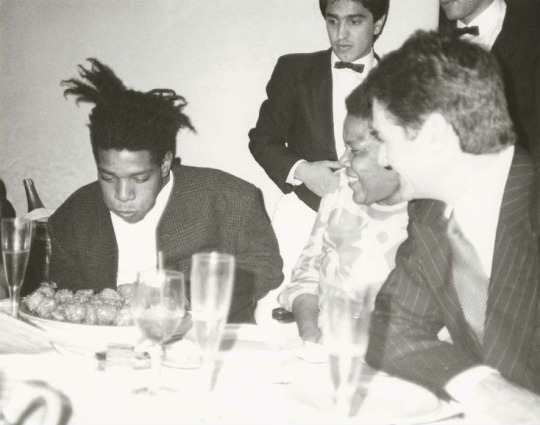
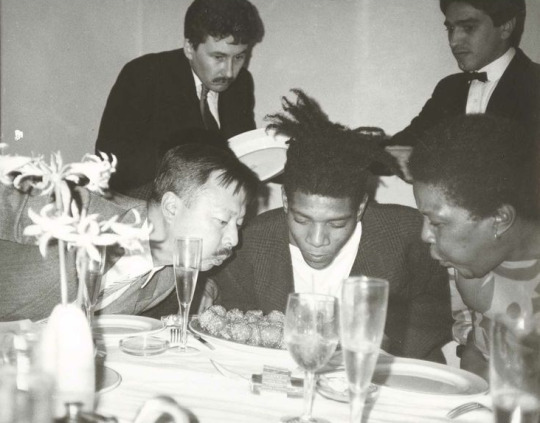
Jean-Michel Basquiat celebrating his birthday early with his mother Matilde Andrades and Michael Chow at Mr Chow in New York City on December 19, 1985.
Photos by Andy Warhol
241 notes
·
View notes
Link
Check out this listing I just added to my Poshmark closet: DOC MARTENS BASQUIAT II 1461 EDITION.
0 notes
Photo

Jean-Michel Basquiat
Basquiat was born on December 22, 1960, in Park Slope, Brooklyn, New York City, the second of four children to Matilde Basquiat (née Andrades, 1934–2008) and Gérard Basquiat (1930–2013).[1] He had an older brother, Max, who died shortly before his birth, and two younger sisters, Lisane (b. 1964) and Jeanine (b. 1967).[2][3] His father was born in Port-au-Prince, Haiti and his mother was born in Brooklyn to Puerto Rican parents.[4] He was raised Catholic.[5]
Matilde instilled a love for art in her young son by taking him to local art museums and enrolling him as a junior member of the Brooklyn Museum of Art.[1][6] Basquiat was a precocious child who learned to read and write by the age of four.[7] His mother encouraged her son's artistic talent and he often tried to draw his favorite cartoons.[8] In 1967, he started attending Saint Ann's School, a private school.[9][10] There he met his friend Marc Prozzo and together they created a children's book, written by Basquiat at the age of seven and illustrated by Prozzo.[8][11]
0 notes
Photo
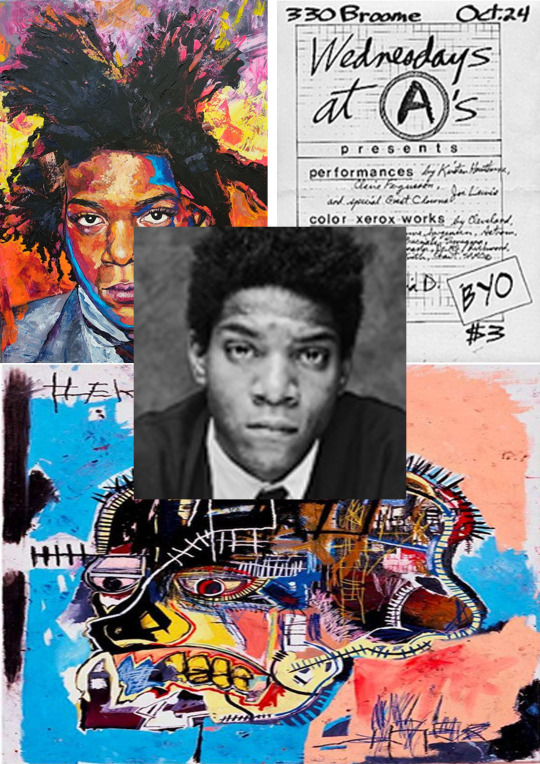
Jean Michel Basquiat
Jean-Michel Basquiat (French: December 22, 1960 – August 12, 1988) was an American artist of Haitian and Puerto Rican descent.
Basquiat first achieved fame as part of SAMO, a graffiti duo who wrote enigmatic epigrams in the cultural hotbed of the Lower East Side of Manhattan during the late 1970s, where rap, punk, and street art coalesced into early hip-hop music culture.
By the early 1980s, his neo-expressionist paintings were being exhibited in galleries and museums internationally.
At 21, Basquiat became the youngest artist to ever take part in document in Kassel.
At 22, he was the youngest to exhibit at the Whitney Biennial in New York. The Whitney Museum of American Art held a retrospective of his art in 1992.
Basquiat's art focused on dichotomies such as wealth versus poverty, integration versus segregation, and inner versus outer experience.
He appropriated poetry, drawing, and painting, and married text and image, abstraction, figuration, and historical information mixed with contemporary critique.
Basquiat used social commentary in his paintings as a tool for introspection and for identifying with his experiences in the black community of his time, as well as attacks on power structures and systems of racism.
Basquiat's visual poetics were acutely political and direct in their criticism of colonialism and support for class struggle.
Since his death at the age of 27 from a heroin overdose in 1988, his work has steadily increased in value.
At a Sotheby's auction in May 2017, Untitled, a 1982 painting by Basquiat depicting a black skull with red and yellow rivulets, sold for $110.5 million, becoming one of the most expensive paintings ever purchased.
It also set a new record high for an American artist at auction.
Jean-Michel Basquiat was born in Brooklyn, New York, on December 22, 1960, shortly after the death of his older brother, Max. He was the second of four children of Matilde Basquiat (née Andrade’s) (July 28, 1934 – November 17, 2008) and Gérard Basquiat (1930 – July 7, 2013).
He had two younger sisters: Liane, born in 1964, and Jeanine, born in 1967.
His father, Gérard Basquiat, was born in Port-au-Prince, Haiti, and his mother, Matilde Basquiat, who was of Puerto Rican descent, was born in Brooklyn, New York.
Matilde instilled a love for art in her young son by taking him to art museums in Manhattan and enrolling him as a junior member of the Brooklyn Museum of Art.
Basquiat was a precocious child who learned how to read and write by the age of four and was a gifted artist.
His teachers, including artist José Machado, noticed his artistic abilities, and his mother encouraged her son's artistic talent.
In 1967, Basquiat started attending Saint Ann's School, an arts-oriented exclusive private school.
There he met his friend Marc Prezzo; together they created a children's book, written by Basquiat at the age of seven, and illustrated by Prezzo.
At the age of seven in 1968, Basquiat was hit by a car while playing in the street.
His arm was broken and he suffered several internal injuries; he eventually underwent a splenectomy.
While he was recuperating from his injuries, his mother brought him a copy of Gray's Anatomy to keep him occupied.
This book would prove to be influential in his future artistic outlook.
His parents separated that year and he and his sisters were raised by their father.
His mother had been committed to a mental institution when he was 10 and thereafter spent her life in and out of institutions.
By the age of 11, Basquiat was fully fluent in French, Spanish and English, and an avid reader of all three languages.
His family resided in Bodrum Hill, Brooklyn, for five years, then moved to San Juan, Puerto Rico in 1974, where Basquiat studied at Saint John's School in Cond ado.
After two years, they returned to New York City.
Due to his mother's instability and family unrest, Basquiat ran away from home at 15.
He slept on park benches in Washington Square Park, and was arrested then returned to the care of his father within a week.
Basquiat left Edward R. Murrow High School in the 10th grade and then attended City-As-School, an alternative high school in Manhattan, home to many artistic students who failed at conventional schooling.
In May 1978, Basquiat and his schoolmate Al Diaz began spray painting graffiti on buildings in Lower Manhattan, working under the pseudonym SAMO (same old shit).
They inscribed poetic and satirical advertising slogans such as "SAMO© AS AN ALTERNATIVE TO GOD."
In June 1978, Basquiat was expelled from City-As-School for pieing the principal.
At the age of 17, his father kicked him out of the house after he decided to drop out of school.
Basquiat worked for the Unique Clothing Warehouse at 718 Broadway in NoHo while continuing to write graffiti at night.
On December 11, 1978, The Village Voice published an article about the SAMO graffiti.
SAMO Xerox poster (1979)
In 1979, Basquiat appeared on the live public-access television show TV Party hosted by Glenn O'Brien, and the two started a friendship.
He made regular appearances on the show over the next few years.
In April 1979, Basquiat met Michael Holman at the Canal Zone Party and they formed the noise rock band Test Pattern, which was later renamed Gray.
Other members of Gray included Shannon Dawson, Nick Taylor, Wayne Clifford and Vincent Gallo.
The band performed at nightclubs, such as Max's Kansas City, CBGB, Hurrah, and the Mudd Club.
Around this time, Basquiat lived in the East Village with his friend Alexis Adler, a Barnard biology graduate.
He often copied diagrams of chemical compounds borrowed from Adler's science textbooks.
She documented Basquiat's creative explorations as he transformed the floors, walls, doors and furniture into his artworks.
He also made postcards with his friend Jennifer Stein.
While selling postcards in SoHo, Basquiat spotted Andy Warhol at W.P.A. restaurant with art critic Henry Geldzahler.
He sold Warhol a postcard titled Stupid Games, Bad Ideas.
In October 1979, at Arleen Schloss's open space called A's, Basquiat showed his SAMO montages using colour Xerox copies of his works.
Schloss also allowed Basquiat to use the space to create his "MAN MADE" clothing, which were upcycled garments he painted on.
In November 1979, costume designer Patricia Field carried his clothing line in her upscale boutique on 8th street in the East Village.
Field also displayed his sculptures in the store window.
After Basquiat and Diaz ended their friendship, the SAMO project ended with the epitaph "SAMO IS DEAD," inscribed on the walls of SoHo buildings in early 1980.
When they separated, a mock wave started for SAMO.
Later that year, Basquiat began filming Glenn O'Brien's independent film Downtown 81 (2000), originally titled New York Beat.
The film featured some of Gray's recordings on its soundtrack.
8 notes
·
View notes
Photo

Jean-Michel Basquiat (1960 - 1988)

Riding With Death, 1988. Acrylic and oil paintstick on linen, 290 x 250 cm
Exhibited at the Vrej Baghoomian Gallery, New York, in April 1988. In August, Jean-Michel dies by an “acute mixed drug intoxication.”
In May 1968, while playing ball in the street, Basquiat is hit by an automobile. He breaks an arm, suffers various internal injuries, and has to have his spleen removed. He is hospitalized at King’s County Hospital for one month.
While recovering, he receives a copy of Gray’s Anatomy from his mother, Matilde Basquiat. The book made a lasting impression... – Basquiat biography
#Jean-Michel Basquiat#painting#gold#skeleton#death#odd#anatomy#book#masterpiece#mother#accident#greys anatomy
11 notes
·
View notes
Text
Response to Emily Harper

Question: What is another topic brought up in Radiant Child that is useful for young readers to relate to, and what does its portrayal do for the reader?
In the picture book Radiant Child, the author Javaka Steptoe guides audiences on a journey through the life of the artist Jean-Michel Basquiat. Instead of dramatic prose and common story-telling conventions, Javaka provides a unique form of art and collage allowing for various interpretations and perceptions of Jean-Michel Basquiat to wonder and float. Though told in simplistic almost rhythmic phrases, Radiant Child does not shy away from deep and sometimes troubling predicaments that children of various backgrounds can relate to. Yet, despite being relatable, Javaka’s interpretation of this artist’s family life and artistic development showcases important coming of age issues that aren’t often given the proper time and recognition. More specifically, the relationship between a boy of color and an influential relationship with his mother.
Throughout Jean-Michel’s story, it is clear that his mother is his driving force and mentor that provides him with the right amount of confidence to succeed. Not that this story has not been told before, but stories similar to this are commonly overlooked or more or less associated with sexual and gender identity. However, Javaka’s method of a simplistic storyline accompanied by art and collage never allows readers the chance to dig deeper into the relationship between Jean-Michel and his mother other than what is noted in the narration. This allowed for more attention to be given to Jean-Michel’s admiration over his mother. A significant passage that thoroughly expressed this type of relationship can be seen on page seven and eight with the phrase
“his art comes from his mother, Matilde,
a Puerto Rican woman,
who designs and sews, cooks and cleans,
and makes the house look like a stylish magazine” (7-8).
It is clear that their relationship expands beyond just mother and son and goes through the channels of apprentice and mentor, which again, I don’t believe is expressed a lot in literature let alone YA literature.
3 notes
·
View notes
Photo
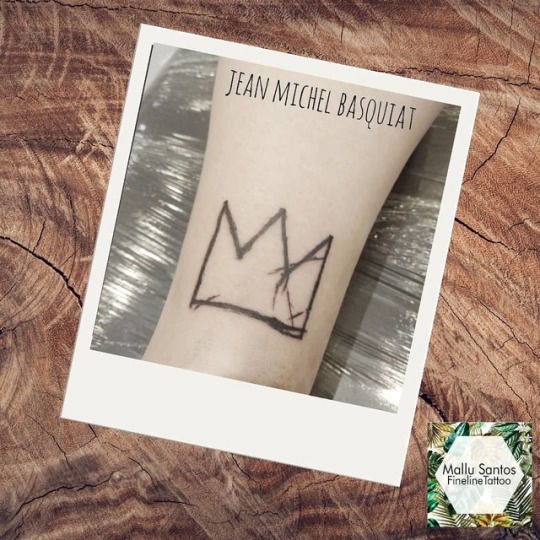
Tattoo da @flasaad, feita no @ocoletivoprojeto. Sempre cheia de bom gosto essa mulher! E quem foi Jean Michel Basquiat? Basquiat tinha ascendência porto-riquenha por parte de mãe e haitiana por parte de pai. Desde cedo mostrou uma aptidão incomum para a arte e foi influenciado pela mãe, Matilde, a desenhar, pintar e a participar de atividades relacionadas ao mundo artístico. Em 1977, aos 17 anos, Basquiat e um amigo, Al Diaz, começaram a fazer grafite em prédios abandonados em Manhattan. A assinatura era sempre a mesma: "SAMO" ou "SAMO shit" ("same old shit", ou, traduzindo, "sempre a mesma merda"). Isso gerou curiosidade nas pessoas, principalmente pelo conteúdo das mensagens grafitadas. Em dezembro de 1978, o veículo Village Voice publicou um artigo sobre as escrituras. O projeto "SAMO" acabou com o epitáfio "SAMO IS DEAD" (SAMO está morto) escrito nas paredes de construções do SoHo nova-iorquino. Em 1978, Basquiat abandonou a escola e saiu de casa, apenas um ano antes de se formar. Mudou-se para a cidade e passou a viver com amigos, sobrevivendo através da venda de camisetas e postais na rua. Um ano depois, em 1979, contudo, Basquiat ganhou um status de celebridade dentro da cena de arte de East Village em Manhattan por suas aparições regulares em um programa televisivo. No fim da década de 1970, Basquiat formou uma banda chamada Gray, com o então desconhecido músico e ator Vincent Gallo. Com o conjunto, tocaram em clubes como Max's Kansas City, CBGB, Hurrahs e o Mudd Club. Basquiat e Gallo viriam a trabalhar em um filme chamado Downtown 81 (também conhecido por "New York Beat Movie"). A trilha sonora deste tinha algumas gravações raras da Gray. A carreira cinematográfica de Basquiat também incluiu uma aparição no vídeo "Rapture" da banda Blondie. Basquiat começou a ser mais amplamente reconhecido em junho de 1980 quando participou do The Times Square Show, uma exposição de vários artistas patrocinada por uma instituição de nome "Colab". Em 1981, o poeta, crítico de arte e "provocador cultural" Rene Ricard publicou um artigo em que comentava sobre o artista. Isso ajudou a catapultar de vez a carreira de Basquiat internacionalmente. Nos anos consecutivos, (em Villa Santos Tattoo) https://www.instagram.com/p/ByyLiVuAP3A/?igshid=1h0ag0z27cm8w
0 notes
Link
Check out this listing I just added to my Poshmark closet: DOC MARTENS BASQUIAT II 1461 EDITION.
0 notes
Photo
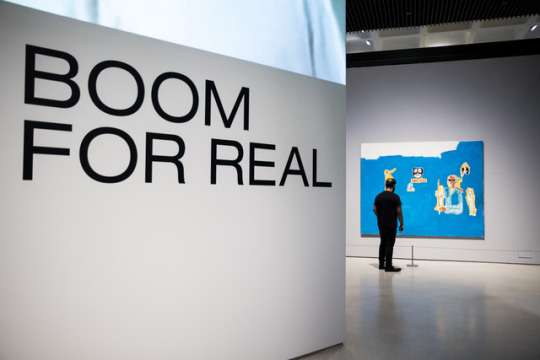
Jean-Michel Basquiat: Boom For Real
Barbican Art Gallery
21st September - 28th January, 2018
‘Boom For Real’ at the Barbican is an absolutely incredible exhibition showcasing the works and life of the neo-expressionist art legend, Jean-Michel Basquiat.
Basquiat was an American artist who first acquired fame as part of SAMO, a graffiti duo who wrote enigmatic messages and epigrams in the Lower East Side of Manhattan during the late 1970’s, where the hip-hop, punk, and street art movements coalesced.
During the early 1980’s Basquiat was exhibiting his neo-expressionist paintings in galleries and museums all over the globe.
Basquiat was born in Brooklyn, New York and from a very early age his mother, Matilde, installed a love of art into him. She would take him to art museums in Manhattan, and enrolled him as a junior member at the Brooklyn Museum of Art. Basquiat was an incredibly gifted child who learned to read and write by the young age of four, and had was fully fluent in French, Spanish and English by age eleven. Basquiat’s incredible artistic talent was noticed at a young age, especially by his teacher, artist Jose Machado, and his mother, who highly encouraged her son’s artistic talent.
At the age of seven Basquiat was hit by a car while playing in the street. His arm was broken and he suffered severe internal injuries and eventually he underwent a splenectomy. While he was recovering from his injuries his mother bought him the Gray’s Anatomy book to keep him occupied. The book would be a huge inspiration to Basquiat’s future artistic outlook.
That year however Basquiat’s parents split and Basquiat and his went to live with his father, when he was thirteen his mother was committed to a mental institution and spent time in and out of institutes. This spurred Basquiat’s decision to run away from home at fifteen. He slept on park benches and was eventually arrested and returned to his father within a week. He later dropped out of high school and his father banished him from house for this; Basquiat stayed with friends in Brooklyn and began selling t-shirts and homemade post cards to support himself.
It was during his time selling his homemade post cards that Basquiat met Andy Warhol. Warhol was a huge idol of Basquiat’s and he approached him outside a café to sell him a post card. Warhol’s friend whom he was with dismissed Basquiat’s work claiming he was ‘too young’, however Warhol immediately took an interest in Basquiat and bought a postcard for a dollar, he then invited him to visit him one day at his studio, in hopes to collaborate and view more of this promising young artist. The next time they met Warhol invited Basquiat to his studio, requesting a painting from him, Basquiat painted a self portrait of himself and Warhol side by side, he delivered it to Warhol, the paint still dripping, who loved it and so their incredible friendship began. Also featured is a letter from Anna Wintour writing to Basquiat explaining that she loves the work by Basquiat and Warhol, and that she apologises for not being able to feature them in the 1984 January issue, but will hold their works for another cover.
Basquiat went from being homeless and unemployed, to selling a single painting for up to $25,000 in a matter of years. In 1976 Basquiat and friend Al Diaz began spray painting graffiti on buildings in Lower Manhattan, working under the pseudonym SAMO. SAMO stood for, ‘Same Old Shit’ and the pair would scribe enigmatic messages such as, “Plush safe he think… SAMO” and, “SAMO…For Those Of Us, Who Merely Tolerate Civilization…”
Unique’s founder Harvey Russack discovered Basquiat painting a building one night, they became friends and he offered him a job. Eventually Basquiat and Diaz ended their friendship, the SAMO project ended with the epitaph “SAMO IS DEAD”, inscribed on the walls of SoHo buildings in 1979.
The exhibition takes viewers around different sections of Basquiat’s life and works. This includes a cinematic area playing ‘Downtown 81(New York Beat)’. A film written by Glenn O’Brien, a friend of Basquiat’s, who was well known for his music column for Andy Warhol’s Interview magazine, as well as his show TV party. O’Brien was writing a script for a feature film about the downtown scene and decided Basquiat should play the lead role. The one hour and thirteen minute long film shows a day in the life of a down-and-out artist, enriched by a musical soundtrack from Mudd Club favourites, with a few whimsical touches, including a spectacular cameo from Blondie’s Debbie Harry as a fairytale princess. The film was released after some financial struggles in 2000, however, because the original dialogue audio was lost, actor Saul Williams dubbed Basquiat’s voice. The film immediately captivates viewers with its intense soundtrack, its simplicity and unique back-alley charm, it serves as a remarkable document of the run-down city that gave rise to the vibrancy of downtown culture.
In the middle of the exhibition hall stands a gigantic pillar with quotes of Basquiat’s printed onto it. On one side viewers can see the quote, “I never went to art school… I just looked… that’s where I think I learned about art, by looking at it”. On another side of the pillar a video is projected of Basquiat dancing in his studio in 1985. This video is incredibly powerful as it shows Basquiat as he was, a normal fun loving person who enjoyed music and enjoying himself, it shows him as more than just a name.
The ‘Beat Bop’ section of the exhibition shows viewers the musical side of Basquiat. Hip-hop was a huge new force in the 1980s that pushed it’s movement forward. Basquiat was introduced to this in the late 1970s when Fab 5 Freddy played basquiat cassette recordings of live rap performances from parties in the South Bronx and Harlem. He also introduced him to emerging figures from the scene, including experimental artist-musician Rammellzee and graffiti artist Toxic. In November 1982 Basquiat made a trip to Los Angeles, he was joined on the West Coast by Rammellzee and Toxic who jokingly referred to themselves as the ‘Hollywood Africans’ in reference to the inescapable racism in the film industry. Basquiat then made this the satirical title of his painting, which was a powerful portrait of the trio. The painting featured references and the words, ‘Beat Bop’ ‘Sugar Cane’ and ‘Satire’, it also includes the phrase “Hollywood Africans From The Nineteen Forties” in reference to the famous American actress, Hattie McDaniel’s. McDaniel’s is best known for her role as “Mammy” in Gone with the Wind (1939), for which she received the Academy Award for Best Supporting Actress, the first Academy Award to be won by an African American entertainer. McDaniel was also the first black woman to sing on radio in the United States. McDaniel has two stars on the Hollywood walk of Fame: one for her contribution to radio and one for her acting in motion pictures. In 1975 she was introduced into the Black Filmmakers Hall of Famed in 2006 became the first black Oscar winner honoured with a US postage stamp. McDaniel’s lifetime achievements make her an incredible icon in African-American history, of which Basquiat could not ignore featuring her in his work.
Featured here is the record ‘Beat Bop’ (1983) which was a single produced by Basquiat and Rammellzee. Basquiat also produced the album cover art for the sleeve, featuring anatomical drawings and his iconic crown. The music is an experimental and abstract sound, perfect for a time that was all about breaking down barriers.
Viewers are welcomed to see the fantastic and surreal self portraits of Basquiat at this exhibition. Basquiat was inspired by the creative possibilities of identity. The name Aaron is written on a number of early worls, which could possibly relate to the black baseball player Hank Aaron (who beat Babe Ruth’s home run record in 1974). But Basquiat may also have been referencing the black antihero of Shakespeare’s Titus Andronicus and the brother of Moses in the Old Testament, who frees the Israelites from slavery.
Basquiat has been very clear about his painting that ‘a lot of them are self portraits’, though in a number of different guises. Basquiat’s self portraits are full of life and colour, but they also feature many heavy, dark lines and mysterious quotes, symbols, and dates, relating to his lifer his inspirations. Basquiat often mocked the art world and it’s tendency to reduce artists t their biography, but he was also self-conscious of his youth and the stereotyping of black artists.
Featured in the ‘Self Portrait’ section is “Untitled (Football Helmet)” (1981-1984). It is a customised football helmet by basquiat, which he painted over using blue and white paint. Human hair is also involved in the personalisation, which could very possibly be Basquiat’s own. Black sporting heroes were an important theme for Basquiat and he celebrated their achievements in many of his works.
One of Basquiat’s most stunning paintings featured is ‘King Zulu’ (1986), which features a saxophone player against a bright blue backdrop. The colours used are very clean and bright colours, such as blue and gold. The painting is in reference to jazz musicians and features a portrait of Louis Armstrong, who was crowned ‘King Zulu’ at the Mardi Gras parade in 1949, Armstrong was one of the most influential figures in jazz.
In the middle of the painting there is a white face featured, however it has been painting black, stopping around the eyes and mouth. This face is a satirical reference to the racism african-american entertainers received, where rather than hire black entertainers they would have people coat their faces in black paint, known as ‘black-facing’.
‘Plastic Sax’ (1984) also heavily features blue and gold colours, showing many faces and musical references. The heavy use of blue paint could be in reference to the musical genre Blues. In Basquiat’s self portrait of himself and Andy Warhol he has even painted himself on a blue background, again this is possibly a reference to Blues music, whereas Warhol is on a white/cream background. We already know that Basquiat was a huge music lover and was heavily inspired by music, often he would listen to music or have TV on while he worked, so it is most probable that his consistent use and apparent love of blue paint could be a connection to Blues music. The painting also features Japanese script and symbols relating to Basquiat’s trip to Japan.
One of Basquiat’s self portraits viewers should be sure to take note of is ‘Self Portrait’ (1981) which features two sides of Basquiat, both seen through his own eyes. One side of Basquiat seems to be a calmer, friendlier version of himself, whereas the other version of himself features a malicious grin with the eyes and mouth lines in red, while the bust rests on top of a red smear that almost resembles blood. The portraits are alongside the names Ben Webster and Theolonious Monk, which are repeated over the work. This shows Basquiat placing himself between and alongside two heroes - representing the achievements and obstacles overcome by back artists.
Basquiat is quoted saying, “I get my facts from books, stuff on atomizers, the blues, ethyl alcohol, geese in Egyptian glyphs […] I don’t take credit for my facts. The facts exist without me.”
The exhibition contains a collection of books that were owned by Basquiat, including Basquiat’s original copies of, ‘Leonardo da Vinci, 1452–1519, 1966’, ‘Ross Russell, Bird Lives! The High Life and Hard Times of Charlie ‘Yardbird’ Parker, 1973’, ‘Frank Driggs and Harris Lewine, Black Beauty White Heat: A Pictorial History of Classic Jazz, 1920–1950, 1982’. The exhibition features an incredible collection of books that inspired Basquiat’s work that viewers should definitely add to their reading lists. Basquiat took inspiration from a dizzying array of source material. Often in his studio books were spread open all over his studio floor, records were playing and the television always on.
‘Untitled (Alice in Wonderland)’ (1983) features familiar characters from Lewis Carroll’s Alice in Wonderland, including the Mad Hatter, complete with his signature teacups from his famous tea party and his ’10/6’ note in his well-known top hat. Also visible are Tweedle Dum and Tweedle Dee, the Caterpillar, and of course the Cheshire Cat makes an appearance in one corner, beaming from ear to ear. The cartoon style Basquiat has used shows that the Disney film adaption from 1951 was the inspiration for this piece. The collage of characters is held together by masking tape which further creates a complex and unique design. Basquiat used this as the basis for ‘Wine of Babylon’ (1984) in which he gave the Mad Hatter a black face. This transformation challenged the overwhelming dominance of white characters within popular culture.
Cartoons were a huge inspiration to Basquiat’s work, often seen are references to Alfred Hitchcock’s works, Disney, cartoons such as Popeye, Felix the Cat, and Voyage to the Bottom of the Sea. It makes sense for television and movies to be in Basquiat’s mind while creating his art as he almost always had television on in the background while he worked. This love and enjoyment of cartoons and insistence on using them in his work comes from his early aspirations to be a cartoonist.
‘A Panel of Experts’ (1982), again shows Basquiat’s huge interest in cartoons as it features popular Looney Toons characters, alongside the words, ‘Beep Beep’, in reference to the Roadrunner.
The painting also contains the word ‘sugar’ over and over; ’Sugar’ and ‘Sugar Canes’ are seen a significant amount in Basquiat’s works. ‘Untitled’ (1984), shows the words ‘sugar’ and ‘sugar cane’ alongside breadfruit, which was a cheap source of food for slaves, while delivering the message of Britain’s past involving slavery. In the background of many of his paintings Basquiat makes sure the treatment and lives of people of black origin is never forgotten, consistently and beautifully delivering his message.
‘Jawbone of an ass’ (1982) is covered in scrawlings by Basquiat of Bible quotes and heroes and characters of myth and legend. The title comes from the Bible quote, ‘Then Samson said, “With a donkey’s jawbone I have made donkey’s of them. With a donkey’s jawbone I have killed a thousand men.”’ Names featured include Alexander and Cleopatra. Alexander is in reference to Alexander the Great, who is often known as one of the most influential people in history.
One of the greatest generals and military strategists of all time, Roman General, Scipio also has his name featured. Although regarded as one of the greatest generals of all time, Scipio was reviled by other patricians of his day and was tried for bribery and treason, charges that were meant to discredit him before the public. Disillusioned by the ingratitude of his peers, Scipio left Rome and withdrew from public life, but he is still known today as an incredible general and leader. He is best known for his defeat of Hannibal at the final battle of Zama in 202 BC.
‘Hannibal’ is also featured, with connections to both Hannibal whom Scipio defeated, but mostly in connection to the rhyme ‘Hannibal Lector — Hector’, from the Trojan War. Hector was a Trojan prince and the greatest fighter for Troy in the Trojan War. Hector was known for his courage and nobility. Homer describes hector as being peace-loving, thoughtful as well as bold, a good son, husband and father, and without darker motives. Basquiat often used many religious references in his work, along with heroes from myths and philosophy.
The final room of the exhibition is playing a short 21 minute video interview with Basquiat, titled, ‘A Conversation with Basquiat’(1985). Interviewers Becky Johnston and Tamra Davis were incredibly lucky to interview basquiat in June 1985 as he rarely did interviews and felt uncomfortable doing so. It so happened that the three were friends and had gone clubbing the night before and discussed the possibility of doing an interview as part of a film Davis was shooting on Basquiat. Davis and Basquiat first met in the early 1980s at an opening at Ulrike Kantor Gallery, where Davis worked. Basquiat said to her, “Hey, let’s put some music on” and he transformed the back room into an exclusive dance space.
Basquiat did very few formal interviews, which makes this interview a rare and beautiful opportunity to enjoy an intimate conversation between friends.
Despite being one of the most successful artists of his time Basquiat struggled with a heroin addiction, which began to interfere with his personal relationships. Horrifically, Basquiat died at an upsetting young age of 27, of a heroin overdose.
However, only Basquiat’s physical form died that day. Basquiat was such an inspiration in the art world that his soul lived on through not only his own art, but through other’s in film, literature, and mostly through music. Basquiat is referenced in Jay Z and Frank Ocean’s song “Oceans”: “I Hope my black skin don’t dirt this white tuxedo before the Basquiat show” in the 2013 album Magna Carta Holy Grail. Jay and Kanye West also made references to Basquiat on their 2011 collaborative album Watch the Throne, with the lyric, “Basquiats, Warhols serving as my muses”
‘Boom for Real’ is a breathtaking and beyond incredible show.
It is an incredibly beautiful tribute to the life and the art of Jean-Michel Basquiat.
Basquiat was an incredible soul and had an even more incredible mind to match. He was part of a huge artistic family, with members including Andy Warhol, Madonna, and David Bowie. Basquiat was an astonishingly colourful and intelligent being, with a simple attitude towards life, which he displayed in his paintings and the way he interacted with people less fortunate than himself, having been in their shoes. Basquiat’s paintings and his messages that he construed painted him as something almost like an oracle, with his perceptions of the world that he stripped down to their bare essence, then spun them and turned them out in his own creative way.
#Basquiat#Jean-michel basquiat#boom for real#1980s#80s#art#love#barbican#london#expressionism#expressionist#surreal#abstract#stunning#amazing#culture#pop#myth#mypicks#pastart
0 notes
Photo

"Let your freak flag fly." ~ Pascó Salvador Dalí was born in 1904, in Spain. His father, Salvador Dalí y Cusi, was a middle class lawyer and notary. Salvador's father had a strict disciplinary approach to raising children—a style which contrasted sharply with that of his mother, Felipa Domenech Ferres. She often indulged young Salvador in his art and early eccentricities. Young Salvador was a precocious and intelligent child, prone to fits of anger against his parents and schoolmates. Consequently, Dalí was subjected to furious acts of cruelty by more dominant students or his father. The elder Salvador wouldn't tolerate his son's outbursts or eccentricities, and punished him severely. Their relationship deteriorated when Salvador was still young, exacerbated by competition between he and his father for Felipa's affection. In 1921, Dalí's mother, Felipa, died of breast cancer. Dalí was 16 years old at the time, and was devastated by the loss. His father married his deceased wife's sister, which did not endear the younger Dalí any closer to his father, though he respected his aunt. Father and son would battle over many different issues throughout their lives, until the elder Dalí's death. Jean-Michel Basquiat was born in Brooklyn, New York, in 1960. With a Haitian-American father, Gérard Basquiat and a Puerto Rican mother, Matilda Andrades , Basquiat's diverse cultural heritage was one of his many sources of inspiration. Basquiat was a precocious child who learned how to read and write by age four and was a gifted artist. He began drawing at an early age on sheets of paper his father, an accountant, brought home from the office. As he delved deeper into his creative side, his mother strongly encouraged to pursue artistic talents. Matilde instilled a love for art in her young son by taking him to art museums in Manhattan and enrolling him as a junior member of the Brooklyn Museum of Art. In September 1968, when Basquiat was about eight Basquiat dropped out of Edward R. Murrow High School in the tenth grade. His father banished him from the household for dropping out of high school and Basquiat stayed with friends in Brooklyn. [excerpt from biography.com]
0 notes
Photo
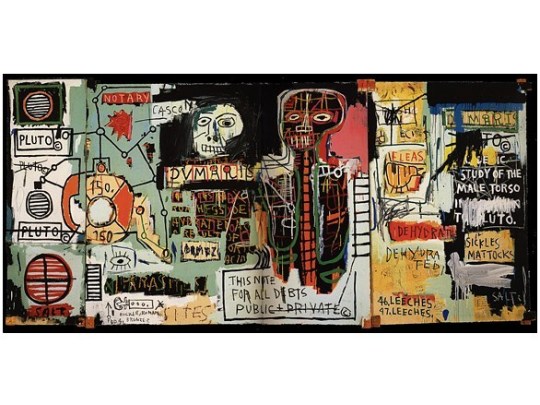
Boom For Real “Believe it or not I can actually draw.” - Jean-Michel Basquiat, Neo-Expressionist Artist. Jean-Michel Basquiat was an American artist. Basquiat first achieved fame as part of SAMO©, an informal graffiti duo who wrote enigmatic epigrams on the streets of the Lower East Side in Manhattan during the late 1970s where the hip hop, post-punk and street art movements had coalesced. By the 1980s this pioneering prodigy was exhibiting his neo-expressionist paintings in galleries and museums internationally. Basquiat was born in Brooklyn, New York, on December 22, 1960 shortly after the death of his elder brother, Max. He was the second of four children of Matilda Andrades (born in Brooklyn of Puerto Rican descent)and Gérard Basquiat (born in Port-au-Prince, Haiti). Basquiat had two younger sisters: Lisane (born in 1964) and Jeanine (born in 1967). Matilde instilled a love for art in her young son by taking him to art museums in Manhattan and enrolling him as a junior member of the ‘Brooklyn Museum of Art’. Basquiat was a precocious child who learned how to read and write by age four and was a gifted artist. His teachers, such as artist Jose Machado, noticed his artistic abilities and his mother encouraged her son's artistic talent. In 1967, Basquiat started attending Saint Ann's an arts-oriented exclusive private school. By the age of 11, Basquiat was fully fluent in French, Spanish and English. Whilst at St Annes’ Basquait collaborated with his friend Marc Prozzo, creating a children's book, written by Basquiat and illustrated by Prozzo. Basquiat became an avid reader of Spanish, French, and English texts and a competent athlete, competing in track events. #chapeaulondon #chapeaublog #dedicatedtothethingswelove #wordsandpictures #amazing #london #lifestyle #jeanmichelbasquiat #artist #neoexpressionist #boomforreal #barbican #newyork #london #samo #graffiti (at Barbican Centre)
#london#wordsandpictures#barbican#chapeaulondon#chapeaublog#samo#boomforreal#artist#amazing#lifestyle#dedicatedtothethingswelove#jeanmichelbasquiat#newyork#neoexpressionist#graffiti
0 notes